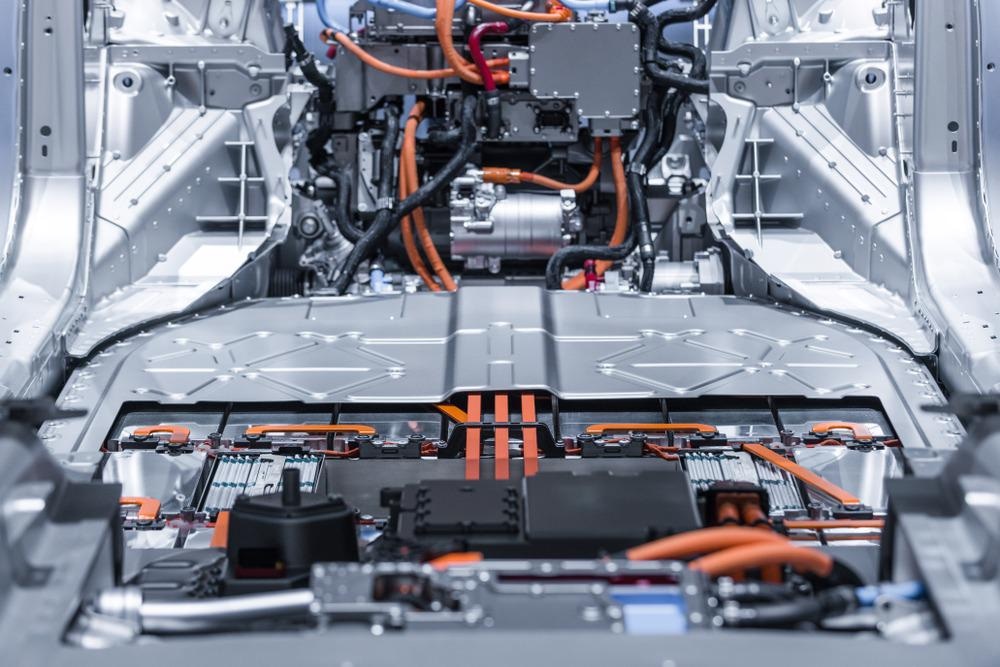New research, published in the journal Energy Storage Materials, details a GPE synthesizing process and reveals that this could be a promising approach for engineering stable and conductive Li/polymer electrolyte interfaces for dendrite-free-lithium metal batteries.

Study: An Efficient Gel Polymer Electrolyte for Dendrite-Free and Long Cycle Life Lithium Metal Batteries. Image Credit: Sergii Chernov/Shutterstock.com
Lithium metal batteries (LMBs) are lithium batteries with an anode from lithium metal. They are hindered by a range of issues, including nonuniform dendritic electrodeposition when used with liquid lithium electrolytes. This results in safety hazards, poor life cycles, and insufficient coulombic efficiencies, limiting the application use of lithium metal batteries.
Now, a team of researchers at the University of Illinois, Chicago, have developed and synthesized an efficient, novel gel polymer electrolyte (GPE) for use in LMBs. This GPE, the team report, can enable uniform and nondendritic Li electrodeposition, longer cycle life, and improve coulombic efficiencies.
Lithium Dendrites
Dendrites form when extra lithium ions build up on the anode surface as a result of not being absorbed into the anode. They resemble a tree-like structure and can cause catastrophic battery failures, short circuits, and even fires.
Preventing dendrite growth is key to preserving battery function and ensuring a good service life while maintaining safety. Lithium dendrite growth is influenced by a number of parameters, including electrolytes, and electrolyte convection. These factors often determine electrolyte dynamics.
The intrinsic chemical reactivity of Li metal, that reacts with almost all organic liquid electrolytes, make liquid electrolytes unsuitable in LMBs. Besides, flammability, toxicity, and solvent leakage further hinder practical commercial applications of LMBs when used with liquid electrolytes
Reza Shahbazian-Yassar, Corresponding Author, Associate Professor, University of Illinois
Due to the poor performance of liquid electrolytes, the team saw the need to develop a viable alternative, hence their work on synthesizing a gel polymer electrolyte that could be used in lithium metal batteries.
Gel Polymer Electrolytes
Gel Polymer Electrolytes (GPEs) are potential alternatives to liquid electrolytes and show promise in terms of hi Li-ion conductivity at ambient temperatures, as well as good electrode-electrolyte interfacial contact.
“A GPE made of a polymer matrix swollen by a liquid electrolyte can combine the advantages of the liquid electrolyte and solid component in a single system,” says Shahbazian-Yassar.
Amongst the candidates for polymer electrolytes, the team identified polyethylene oxide as a suitable contender owing to its compatibility with lithium and electrically insulating nature. However, the team needed to modify the polyethylene oxide by introducing methacrylate functionalities (cross-linkable groups) to end chains of regular polyethylene oxide.
This novel approach allowed the team to synthesize a gel polymer electrolyte, which demonstrated superior cycle performance of the LMBs with the GPE. Shahbazian-Yassar explains, “This can be correlated to the Li ions regulation via oxygen atoms of the modified polyethylene oxide within the GPE matrix, leading to uniform Li 31 platting/stripping.”
Improving Lithium Metal Batteries
As the race to develop better strategies for lithium-based batteries, including LMBS, accelerates, improving the technology is crucial to the future of the technology and development of energy solutions.
The novel gel polymer electrolyte developed by Shahbazian-Yassar and his team outperforms liquid electrolytes and presents the possibility for improvements in lithium metal battery technology.
In addition to observing uniform and nondendritic Li electrodeposition in the GPE, the team was also able to demonstrate around 70% capacity retention in the LMB after 1000 cycles at 2oC and more than 99 cycles at 20oC.
Therefore, efficient gel polymer electrolyte lithium metal batteries could soon usher in dendrite-free and long cycle life lithium metal batteries and open up new application areas, where previously battery safety and cycle life were mitigating factors.
LMBs have long been considered the most promising batteries, with high energy density for cutting-edge electronic devices such as electric vehicles, autonomous aircraft, and smart grids; therefore, the industry should welcome any improvements to the technology.
Reference
Vahid Jabbari , Vitaliy Yurkiv , Md Golam Rasul , Mahmoud Tamadoni Saray , Ramin Rojaee , Farzad Mashayek , Reza Shahbazian-Yassar , An Efficient Gel Polymer Electrolyte for Dendrite-Free and Long Cycle Life Lithium Metal Batteries, Energy Storage Materials (2022), https://www.sciencedirect.com/science/article/pii/S2405829722000381
Disclaimer: The views expressed here are those of the author expressed in their private capacity and do not necessarily represent the views of AZoM.com Limited T/A AZoNetwork the owner and operator of this website. This disclaimer forms part of the Terms and conditions of use of this website.